Technical Feasibility of Using Water Wells for Energy Production
VerifiedAdded on 2021/05/30
|22
|5336
|92
Report
AI Summary
This report investigates the technical feasibility of utilizing existing water wells within agricultural lands for energy storage and production, focusing on the context of Australia. It begins by outlining the global energy landscape, contrasting renewable and non-renewable sources, and highlighting the challenges associated with each, such as the intermittency of renewable sources and the environmental impact of fossil fuels. The report then explores the interdependence of energy and water, emphasizing the critical role of water in energy production, and the growing concerns regarding water scarcity. It delves into the problems encountered in generating energy from water sources, including inadequate water supply and weather pattern variability, and proposes the use of water wells as a solution for energy storage, particularly in rural areas. The methodology involves identifying relevant information, analyzing selected sources, and writing the findings. The research explores the potential of hydro-electric storage using water wells, with a focus on suitable locations in Australia. The conclusion emphasizes the importance of this research in addressing energy challenges and promoting sustainability within the agricultural sector.
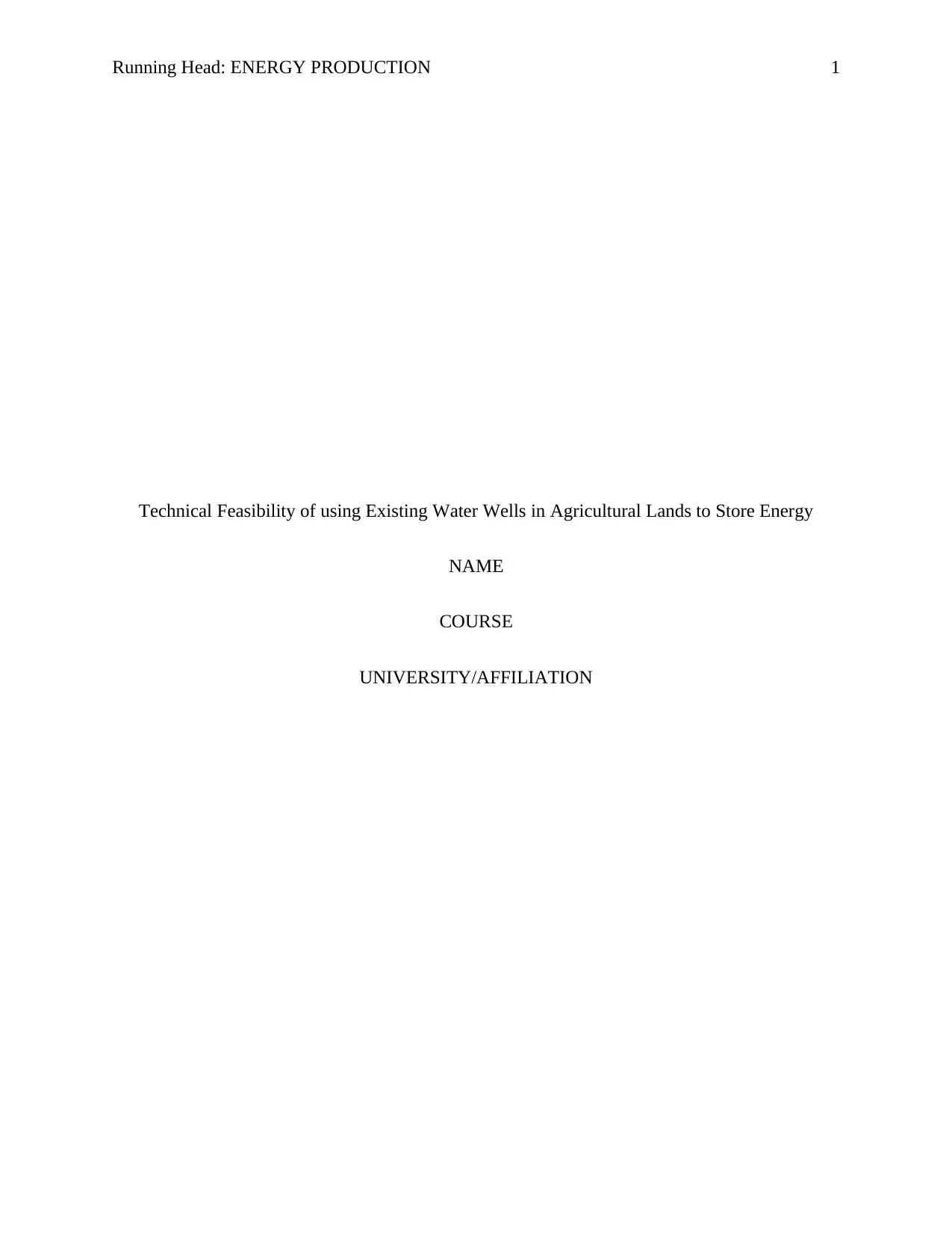
Running Head: ENERGY PRODUCTION 1
Technical Feasibility of using Existing Water Wells in Agricultural Lands to Store Energy
NAME
COURSE
UNIVERSITY/AFFILIATION
Technical Feasibility of using Existing Water Wells in Agricultural Lands to Store Energy
NAME
COURSE
UNIVERSITY/AFFILIATION
Paraphrase This Document
Need a fresh take? Get an instant paraphrase of this document with our AI Paraphraser
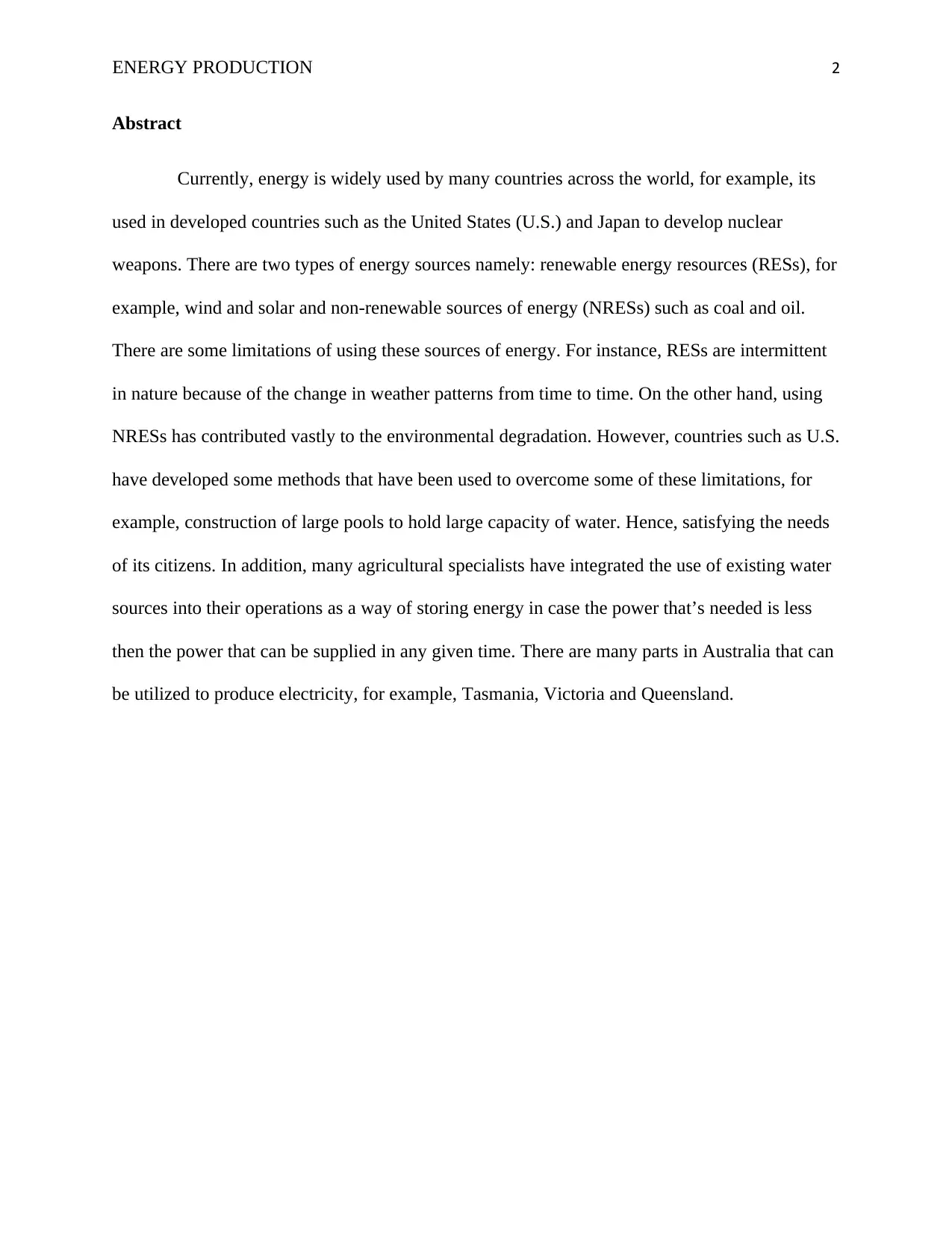
ENERGY PRODUCTION 2
Abstract
Currently, energy is widely used by many countries across the world, for example, its
used in developed countries such as the United States (U.S.) and Japan to develop nuclear
weapons. There are two types of energy sources namely: renewable energy resources (RESs), for
example, wind and solar and non-renewable sources of energy (NRESs) such as coal and oil.
There are some limitations of using these sources of energy. For instance, RESs are intermittent
in nature because of the change in weather patterns from time to time. On the other hand, using
NRESs has contributed vastly to the environmental degradation. However, countries such as U.S.
have developed some methods that have been used to overcome some of these limitations, for
example, construction of large pools to hold large capacity of water. Hence, satisfying the needs
of its citizens. In addition, many agricultural specialists have integrated the use of existing water
sources into their operations as a way of storing energy in case the power that’s needed is less
then the power that can be supplied in any given time. There are many parts in Australia that can
be utilized to produce electricity, for example, Tasmania, Victoria and Queensland.
Abstract
Currently, energy is widely used by many countries across the world, for example, its
used in developed countries such as the United States (U.S.) and Japan to develop nuclear
weapons. There are two types of energy sources namely: renewable energy resources (RESs), for
example, wind and solar and non-renewable sources of energy (NRESs) such as coal and oil.
There are some limitations of using these sources of energy. For instance, RESs are intermittent
in nature because of the change in weather patterns from time to time. On the other hand, using
NRESs has contributed vastly to the environmental degradation. However, countries such as U.S.
have developed some methods that have been used to overcome some of these limitations, for
example, construction of large pools to hold large capacity of water. Hence, satisfying the needs
of its citizens. In addition, many agricultural specialists have integrated the use of existing water
sources into their operations as a way of storing energy in case the power that’s needed is less
then the power that can be supplied in any given time. There are many parts in Australia that can
be utilized to produce electricity, for example, Tasmania, Victoria and Queensland.
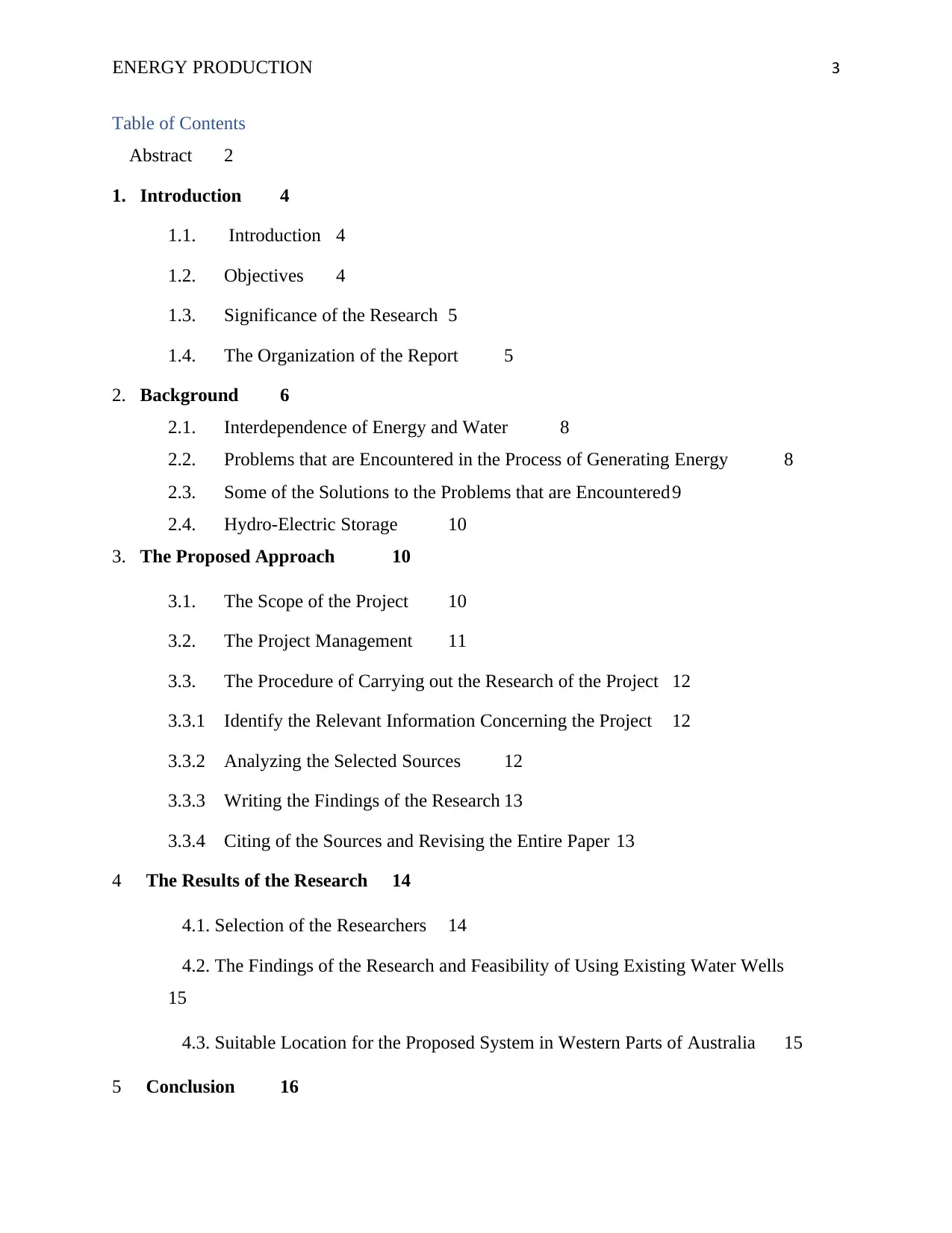
ENERGY PRODUCTION 3
Table of Contents
Abstract 2
1. Introduction 4
1.1. Introduction 4
1.2. Objectives 4
1.3. Significance of the Research 5
1.4. The Organization of the Report 5
2. Background 6
2.1. Interdependence of Energy and Water 8
2.2. Problems that are Encountered in the Process of Generating Energy 8
2.3. Some of the Solutions to the Problems that are Encountered 9
2.4. Hydro-Electric Storage 10
3. The Proposed Approach 10
3.1. The Scope of the Project 10
3.2. The Project Management 11
3.3. The Procedure of Carrying out the Research of the Project 12
3.3.1 Identify the Relevant Information Concerning the Project 12
3.3.2 Analyzing the Selected Sources 12
3.3.3 Writing the Findings of the Research 13
3.3.4 Citing of the Sources and Revising the Entire Paper 13
4 The Results of the Research 14
4.1. Selection of the Researchers 14
4.2. The Findings of the Research and Feasibility of Using Existing Water Wells
15
4.3. Suitable Location for the Proposed System in Western Parts of Australia 15
5 Conclusion 16
Table of Contents
Abstract 2
1. Introduction 4
1.1. Introduction 4
1.2. Objectives 4
1.3. Significance of the Research 5
1.4. The Organization of the Report 5
2. Background 6
2.1. Interdependence of Energy and Water 8
2.2. Problems that are Encountered in the Process of Generating Energy 8
2.3. Some of the Solutions to the Problems that are Encountered 9
2.4. Hydro-Electric Storage 10
3. The Proposed Approach 10
3.1. The Scope of the Project 10
3.2. The Project Management 11
3.3. The Procedure of Carrying out the Research of the Project 12
3.3.1 Identify the Relevant Information Concerning the Project 12
3.3.2 Analyzing the Selected Sources 12
3.3.3 Writing the Findings of the Research 13
3.3.4 Citing of the Sources and Revising the Entire Paper 13
4 The Results of the Research 14
4.1. Selection of the Researchers 14
4.2. The Findings of the Research and Feasibility of Using Existing Water Wells
15
4.3. Suitable Location for the Proposed System in Western Parts of Australia 15
5 Conclusion 16
⊘ This is a preview!⊘
Do you want full access?
Subscribe today to unlock all pages.

Trusted by 1+ million students worldwide
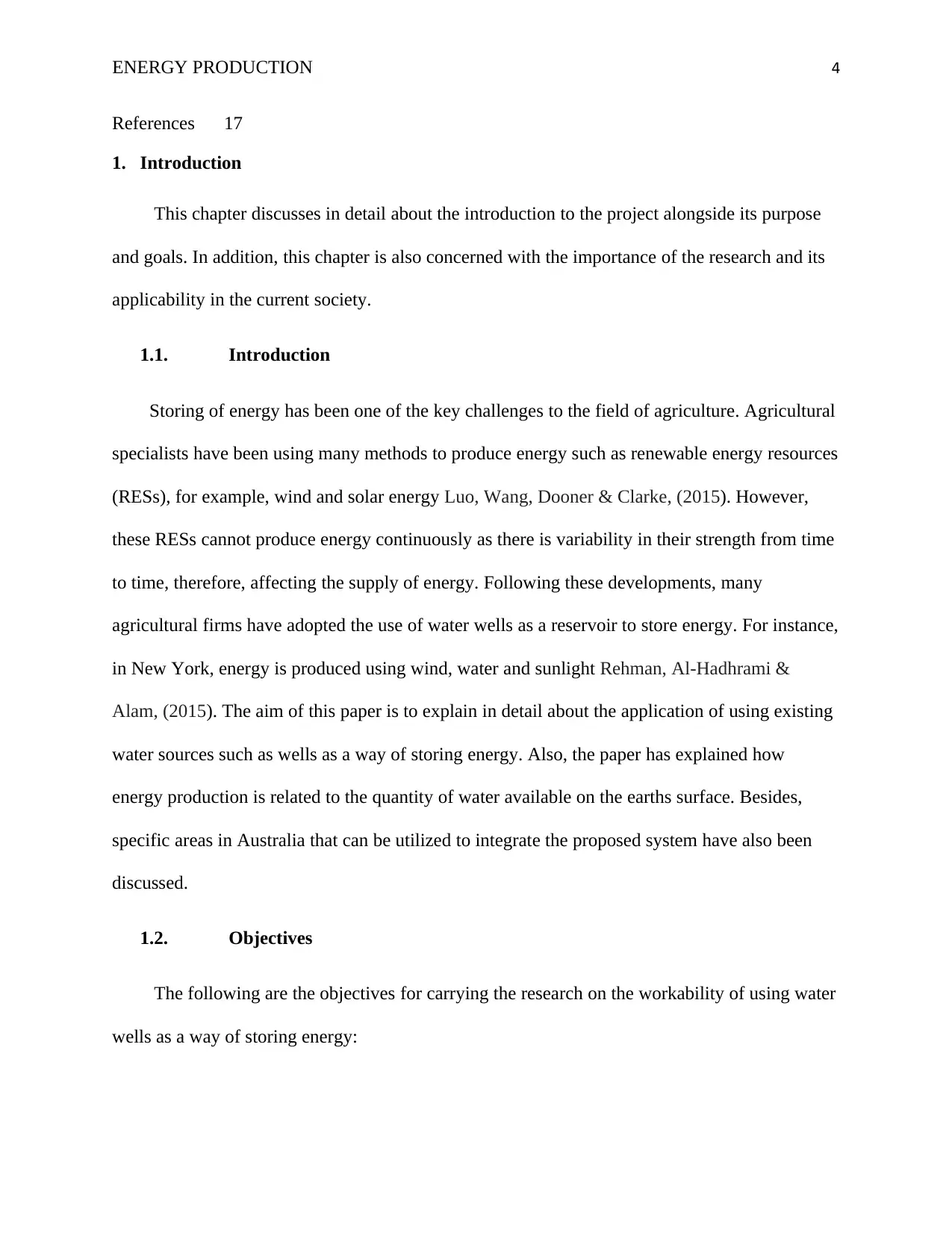
ENERGY PRODUCTION 4
References 17
1. Introduction
This chapter discusses in detail about the introduction to the project alongside its purpose
and goals. In addition, this chapter is also concerned with the importance of the research and its
applicability in the current society.
1.1. Introduction
Storing of energy has been one of the key challenges to the field of agriculture. Agricultural
specialists have been using many methods to produce energy such as renewable energy resources
(RESs), for example, wind and solar energy Luo, Wang, Dooner & Clarke, (2015). However,
these RESs cannot produce energy continuously as there is variability in their strength from time
to time, therefore, affecting the supply of energy. Following these developments, many
agricultural firms have adopted the use of water wells as a reservoir to store energy. For instance,
in New York, energy is produced using wind, water and sunlight Rehman, Al-Hadhrami &
Alam, (2015). The aim of this paper is to explain in detail about the application of using existing
water sources such as wells as a way of storing energy. Also, the paper has explained how
energy production is related to the quantity of water available on the earths surface. Besides,
specific areas in Australia that can be utilized to integrate the proposed system have also been
discussed.
1.2. Objectives
The following are the objectives for carrying the research on the workability of using water
wells as a way of storing energy:
References 17
1. Introduction
This chapter discusses in detail about the introduction to the project alongside its purpose
and goals. In addition, this chapter is also concerned with the importance of the research and its
applicability in the current society.
1.1. Introduction
Storing of energy has been one of the key challenges to the field of agriculture. Agricultural
specialists have been using many methods to produce energy such as renewable energy resources
(RESs), for example, wind and solar energy Luo, Wang, Dooner & Clarke, (2015). However,
these RESs cannot produce energy continuously as there is variability in their strength from time
to time, therefore, affecting the supply of energy. Following these developments, many
agricultural firms have adopted the use of water wells as a reservoir to store energy. For instance,
in New York, energy is produced using wind, water and sunlight Rehman, Al-Hadhrami &
Alam, (2015). The aim of this paper is to explain in detail about the application of using existing
water sources such as wells as a way of storing energy. Also, the paper has explained how
energy production is related to the quantity of water available on the earths surface. Besides,
specific areas in Australia that can be utilized to integrate the proposed system have also been
discussed.
1.2. Objectives
The following are the objectives for carrying the research on the workability of using water
wells as a way of storing energy:
Paraphrase This Document
Need a fresh take? Get an instant paraphrase of this document with our AI Paraphraser
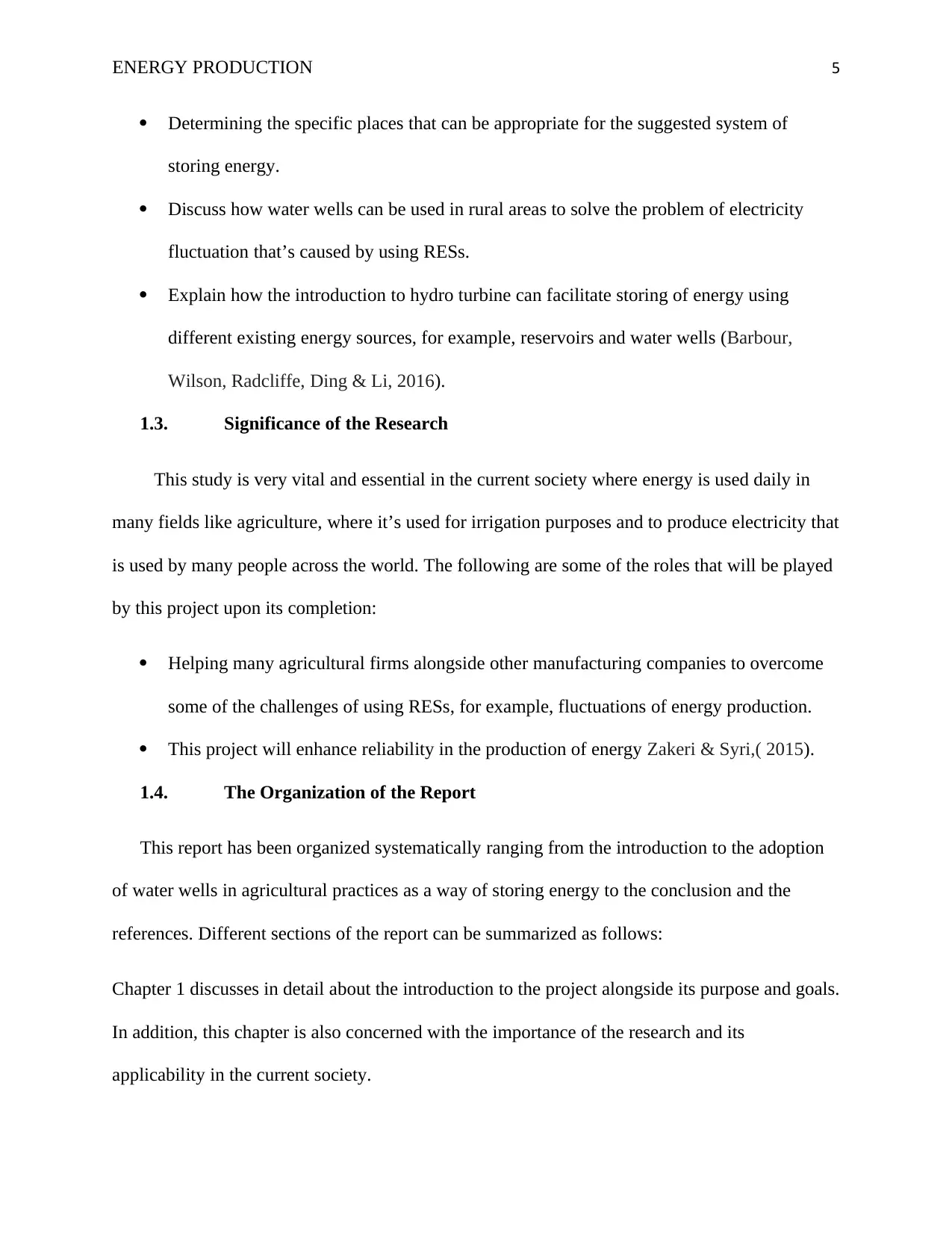
ENERGY PRODUCTION 5
Determining the specific places that can be appropriate for the suggested system of
storing energy.
Discuss how water wells can be used in rural areas to solve the problem of electricity
fluctuation that’s caused by using RESs.
Explain how the introduction to hydro turbine can facilitate storing of energy using
different existing energy sources, for example, reservoirs and water wells (Barbour,
Wilson, Radcliffe, Ding & Li, 2016).
1.3. Significance of the Research
This study is very vital and essential in the current society where energy is used daily in
many fields like agriculture, where it’s used for irrigation purposes and to produce electricity that
is used by many people across the world. The following are some of the roles that will be played
by this project upon its completion:
Helping many agricultural firms alongside other manufacturing companies to overcome
some of the challenges of using RESs, for example, fluctuations of energy production.
This project will enhance reliability in the production of energy Zakeri & Syri,( 2015).
1.4. The Organization of the Report
This report has been organized systematically ranging from the introduction to the adoption
of water wells in agricultural practices as a way of storing energy to the conclusion and the
references. Different sections of the report can be summarized as follows:
Chapter 1 discusses in detail about the introduction to the project alongside its purpose and goals.
In addition, this chapter is also concerned with the importance of the research and its
applicability in the current society.
Determining the specific places that can be appropriate for the suggested system of
storing energy.
Discuss how water wells can be used in rural areas to solve the problem of electricity
fluctuation that’s caused by using RESs.
Explain how the introduction to hydro turbine can facilitate storing of energy using
different existing energy sources, for example, reservoirs and water wells (Barbour,
Wilson, Radcliffe, Ding & Li, 2016).
1.3. Significance of the Research
This study is very vital and essential in the current society where energy is used daily in
many fields like agriculture, where it’s used for irrigation purposes and to produce electricity that
is used by many people across the world. The following are some of the roles that will be played
by this project upon its completion:
Helping many agricultural firms alongside other manufacturing companies to overcome
some of the challenges of using RESs, for example, fluctuations of energy production.
This project will enhance reliability in the production of energy Zakeri & Syri,( 2015).
1.4. The Organization of the Report
This report has been organized systematically ranging from the introduction to the adoption
of water wells in agricultural practices as a way of storing energy to the conclusion and the
references. Different sections of the report can be summarized as follows:
Chapter 1 discusses in detail about the introduction to the project alongside its purpose and goals.
In addition, this chapter is also concerned with the importance of the research and its
applicability in the current society.
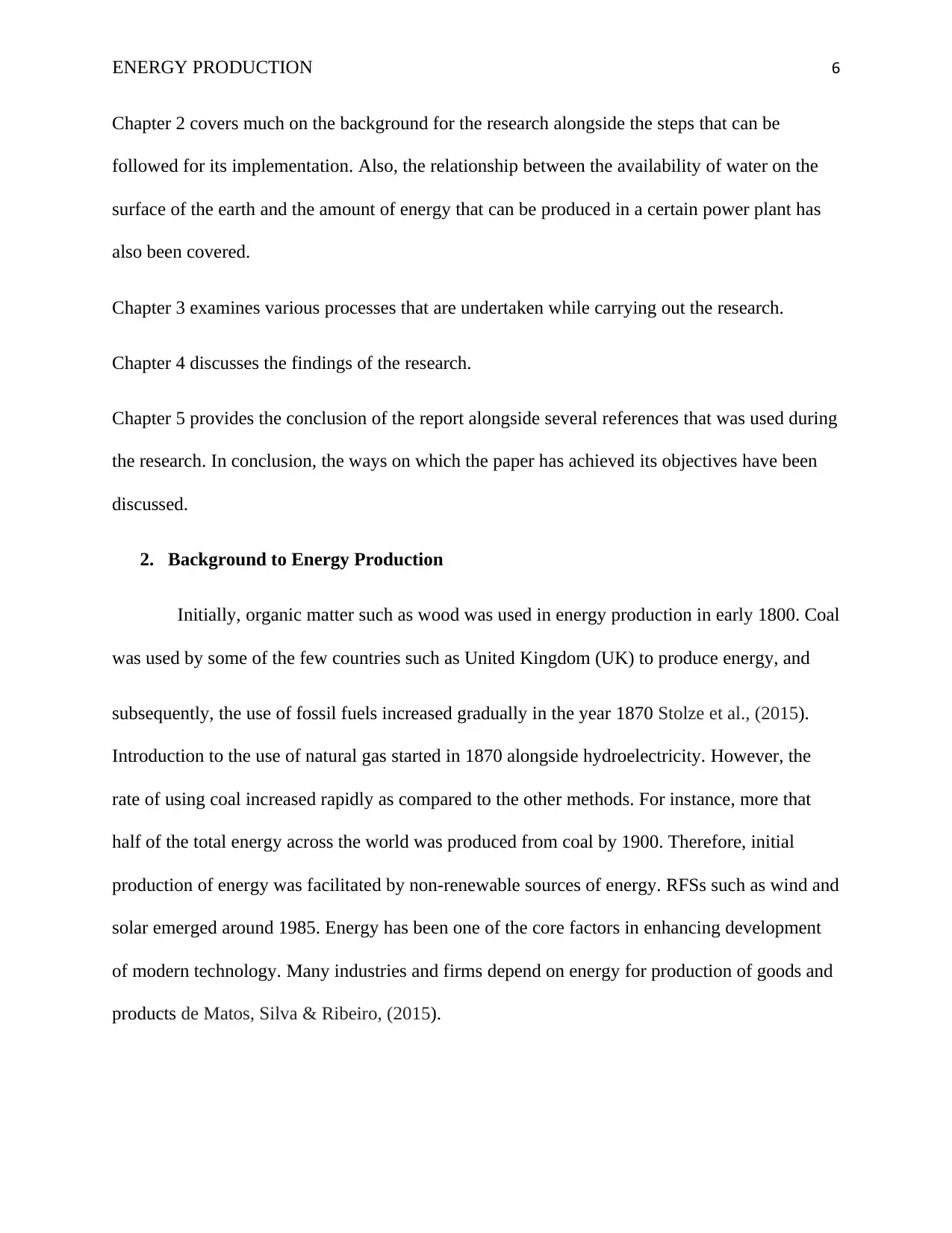
ENERGY PRODUCTION 6
Chapter 2 covers much on the background for the research alongside the steps that can be
followed for its implementation. Also, the relationship between the availability of water on the
surface of the earth and the amount of energy that can be produced in a certain power plant has
also been covered.
Chapter 3 examines various processes that are undertaken while carrying out the research.
Chapter 4 discusses the findings of the research.
Chapter 5 provides the conclusion of the report alongside several references that was used during
the research. In conclusion, the ways on which the paper has achieved its objectives have been
discussed.
2. Background to Energy Production
Initially, organic matter such as wood was used in energy production in early 1800. Coal
was used by some of the few countries such as United Kingdom (UK) to produce energy, and
subsequently, the use of fossil fuels increased gradually in the year 1870 Stolze et al., (2015).
Introduction to the use of natural gas started in 1870 alongside hydroelectricity. However, the
rate of using coal increased rapidly as compared to the other methods. For instance, more that
half of the total energy across the world was produced from coal by 1900. Therefore, initial
production of energy was facilitated by non-renewable sources of energy. RFSs such as wind and
solar emerged around 1985. Energy has been one of the core factors in enhancing development
of modern technology. Many industries and firms depend on energy for production of goods and
products de Matos, Silva & Ribeiro, (2015).
Chapter 2 covers much on the background for the research alongside the steps that can be
followed for its implementation. Also, the relationship between the availability of water on the
surface of the earth and the amount of energy that can be produced in a certain power plant has
also been covered.
Chapter 3 examines various processes that are undertaken while carrying out the research.
Chapter 4 discusses the findings of the research.
Chapter 5 provides the conclusion of the report alongside several references that was used during
the research. In conclusion, the ways on which the paper has achieved its objectives have been
discussed.
2. Background to Energy Production
Initially, organic matter such as wood was used in energy production in early 1800. Coal
was used by some of the few countries such as United Kingdom (UK) to produce energy, and
subsequently, the use of fossil fuels increased gradually in the year 1870 Stolze et al., (2015).
Introduction to the use of natural gas started in 1870 alongside hydroelectricity. However, the
rate of using coal increased rapidly as compared to the other methods. For instance, more that
half of the total energy across the world was produced from coal by 1900. Therefore, initial
production of energy was facilitated by non-renewable sources of energy. RFSs such as wind and
solar emerged around 1985. Energy has been one of the core factors in enhancing development
of modern technology. Many industries and firms depend on energy for production of goods and
products de Matos, Silva & Ribeiro, (2015).
⊘ This is a preview!⊘
Do you want full access?
Subscribe today to unlock all pages.

Trusted by 1+ million students worldwide
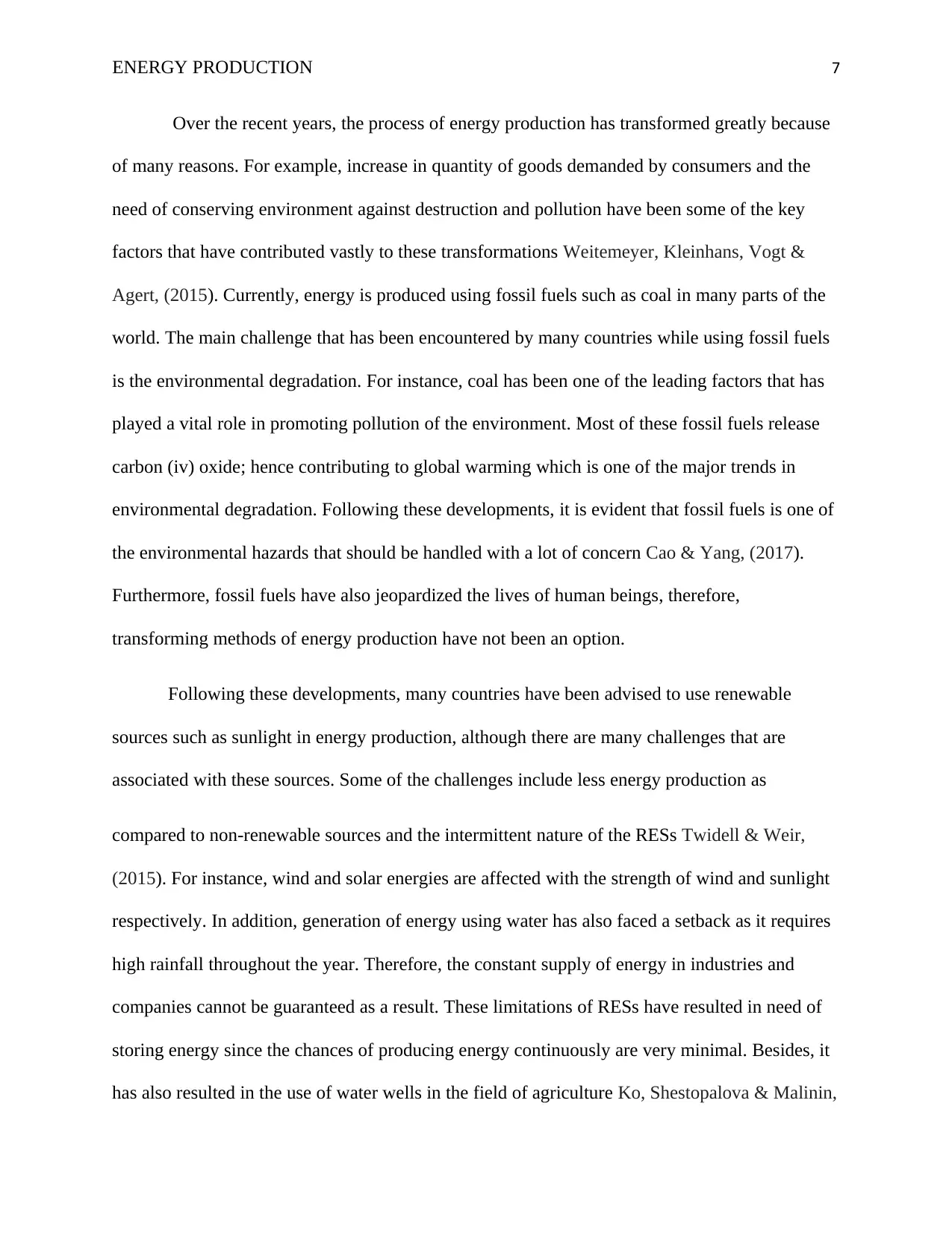
ENERGY PRODUCTION 7
Over the recent years, the process of energy production has transformed greatly because
of many reasons. For example, increase in quantity of goods demanded by consumers and the
need of conserving environment against destruction and pollution have been some of the key
factors that have contributed vastly to these transformations Weitemeyer, Kleinhans, Vogt &
Agert, (2015). Currently, energy is produced using fossil fuels such as coal in many parts of the
world. The main challenge that has been encountered by many countries while using fossil fuels
is the environmental degradation. For instance, coal has been one of the leading factors that has
played a vital role in promoting pollution of the environment. Most of these fossil fuels release
carbon (iv) oxide; hence contributing to global warming which is one of the major trends in
environmental degradation. Following these developments, it is evident that fossil fuels is one of
the environmental hazards that should be handled with a lot of concern Cao & Yang, (2017).
Furthermore, fossil fuels have also jeopardized the lives of human beings, therefore,
transforming methods of energy production have not been an option.
Following these developments, many countries have been advised to use renewable
sources such as sunlight in energy production, although there are many challenges that are
associated with these sources. Some of the challenges include less energy production as
compared to non-renewable sources and the intermittent nature of the RESs Twidell & Weir,
(2015). For instance, wind and solar energies are affected with the strength of wind and sunlight
respectively. In addition, generation of energy using water has also faced a setback as it requires
high rainfall throughout the year. Therefore, the constant supply of energy in industries and
companies cannot be guaranteed as a result. These limitations of RESs have resulted in need of
storing energy since the chances of producing energy continuously are very minimal. Besides, it
has also resulted in the use of water wells in the field of agriculture Ko, Shestopalova & Malinin,
Over the recent years, the process of energy production has transformed greatly because
of many reasons. For example, increase in quantity of goods demanded by consumers and the
need of conserving environment against destruction and pollution have been some of the key
factors that have contributed vastly to these transformations Weitemeyer, Kleinhans, Vogt &
Agert, (2015). Currently, energy is produced using fossil fuels such as coal in many parts of the
world. The main challenge that has been encountered by many countries while using fossil fuels
is the environmental degradation. For instance, coal has been one of the leading factors that has
played a vital role in promoting pollution of the environment. Most of these fossil fuels release
carbon (iv) oxide; hence contributing to global warming which is one of the major trends in
environmental degradation. Following these developments, it is evident that fossil fuels is one of
the environmental hazards that should be handled with a lot of concern Cao & Yang, (2017).
Furthermore, fossil fuels have also jeopardized the lives of human beings, therefore,
transforming methods of energy production have not been an option.
Following these developments, many countries have been advised to use renewable
sources such as sunlight in energy production, although there are many challenges that are
associated with these sources. Some of the challenges include less energy production as
compared to non-renewable sources and the intermittent nature of the RESs Twidell & Weir,
(2015). For instance, wind and solar energies are affected with the strength of wind and sunlight
respectively. In addition, generation of energy using water has also faced a setback as it requires
high rainfall throughout the year. Therefore, the constant supply of energy in industries and
companies cannot be guaranteed as a result. These limitations of RESs have resulted in need of
storing energy since the chances of producing energy continuously are very minimal. Besides, it
has also resulted in the use of water wells in the field of agriculture Ko, Shestopalova & Malinin,
Paraphrase This Document
Need a fresh take? Get an instant paraphrase of this document with our AI Paraphraser
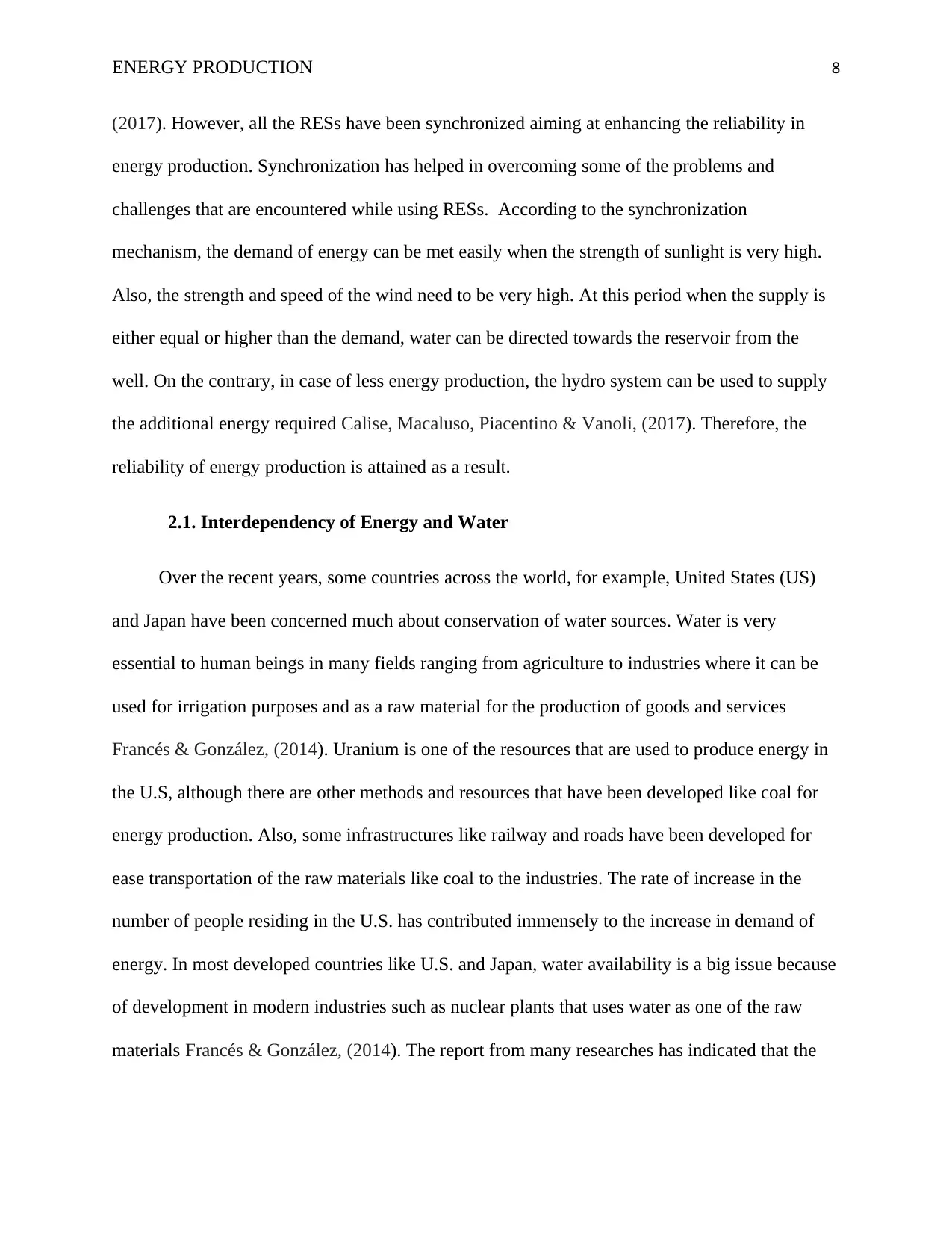
ENERGY PRODUCTION 8
(2017). However, all the RESs have been synchronized aiming at enhancing the reliability in
energy production. Synchronization has helped in overcoming some of the problems and
challenges that are encountered while using RESs. According to the synchronization
mechanism, the demand of energy can be met easily when the strength of sunlight is very high.
Also, the strength and speed of the wind need to be very high. At this period when the supply is
either equal or higher than the demand, water can be directed towards the reservoir from the
well. On the contrary, in case of less energy production, the hydro system can be used to supply
the additional energy required Calise, Macaluso, Piacentino & Vanoli, (2017). Therefore, the
reliability of energy production is attained as a result.
2.1. Interdependency of Energy and Water
Over the recent years, some countries across the world, for example, United States (US)
and Japan have been concerned much about conservation of water sources. Water is very
essential to human beings in many fields ranging from agriculture to industries where it can be
used for irrigation purposes and as a raw material for the production of goods and services
Francés & González, (2014). Uranium is one of the resources that are used to produce energy in
the U.S, although there are other methods and resources that have been developed like coal for
energy production. Also, some infrastructures like railway and roads have been developed for
ease transportation of the raw materials like coal to the industries. The rate of increase in the
number of people residing in the U.S. has contributed immensely to the increase in demand of
energy. In most developed countries like U.S. and Japan, water availability is a big issue because
of development in modern industries such as nuclear plants that uses water as one of the raw
materials Francés & González, (2014). The report from many researches has indicated that the
(2017). However, all the RESs have been synchronized aiming at enhancing the reliability in
energy production. Synchronization has helped in overcoming some of the problems and
challenges that are encountered while using RESs. According to the synchronization
mechanism, the demand of energy can be met easily when the strength of sunlight is very high.
Also, the strength and speed of the wind need to be very high. At this period when the supply is
either equal or higher than the demand, water can be directed towards the reservoir from the
well. On the contrary, in case of less energy production, the hydro system can be used to supply
the additional energy required Calise, Macaluso, Piacentino & Vanoli, (2017). Therefore, the
reliability of energy production is attained as a result.
2.1. Interdependency of Energy and Water
Over the recent years, some countries across the world, for example, United States (US)
and Japan have been concerned much about conservation of water sources. Water is very
essential to human beings in many fields ranging from agriculture to industries where it can be
used for irrigation purposes and as a raw material for the production of goods and services
Francés & González, (2014). Uranium is one of the resources that are used to produce energy in
the U.S, although there are other methods and resources that have been developed like coal for
energy production. Also, some infrastructures like railway and roads have been developed for
ease transportation of the raw materials like coal to the industries. The rate of increase in the
number of people residing in the U.S. has contributed immensely to the increase in demand of
energy. In most developed countries like U.S. and Japan, water availability is a big issue because
of development in modern industries such as nuclear plants that uses water as one of the raw
materials Francés & González, (2014). The report from many researches has indicated that the
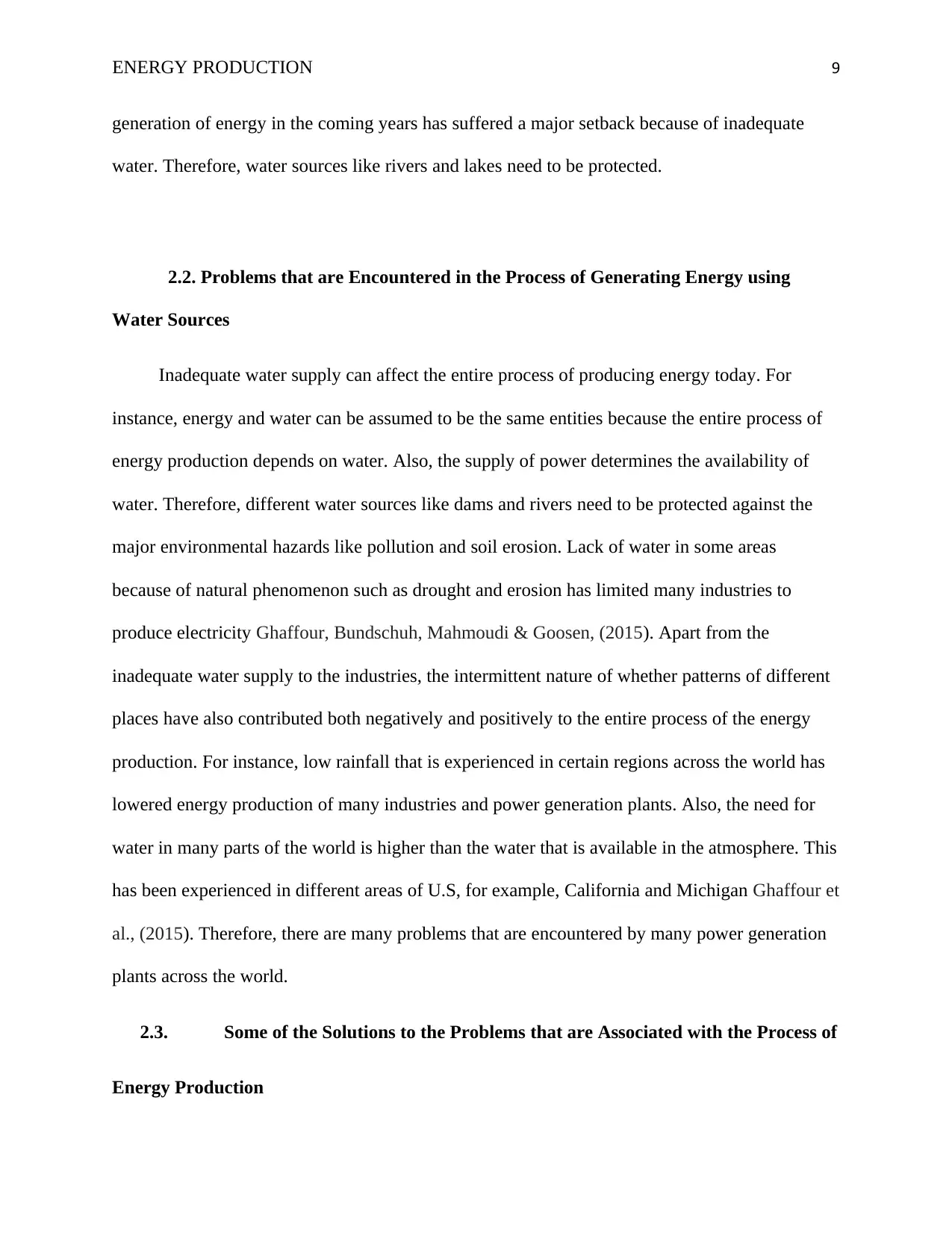
ENERGY PRODUCTION 9
generation of energy in the coming years has suffered a major setback because of inadequate
water. Therefore, water sources like rivers and lakes need to be protected.
2.2. Problems that are Encountered in the Process of Generating Energy using
Water Sources
Inadequate water supply can affect the entire process of producing energy today. For
instance, energy and water can be assumed to be the same entities because the entire process of
energy production depends on water. Also, the supply of power determines the availability of
water. Therefore, different water sources like dams and rivers need to be protected against the
major environmental hazards like pollution and soil erosion. Lack of water in some areas
because of natural phenomenon such as drought and erosion has limited many industries to
produce electricity Ghaffour, Bundschuh, Mahmoudi & Goosen, (2015). Apart from the
inadequate water supply to the industries, the intermittent nature of whether patterns of different
places have also contributed both negatively and positively to the entire process of the energy
production. For instance, low rainfall that is experienced in certain regions across the world has
lowered energy production of many industries and power generation plants. Also, the need for
water in many parts of the world is higher than the water that is available in the atmosphere. This
has been experienced in different areas of U.S, for example, California and Michigan Ghaffour et
al., (2015). Therefore, there are many problems that are encountered by many power generation
plants across the world.
2.3. Some of the Solutions to the Problems that are Associated with the Process of
Energy Production
generation of energy in the coming years has suffered a major setback because of inadequate
water. Therefore, water sources like rivers and lakes need to be protected.
2.2. Problems that are Encountered in the Process of Generating Energy using
Water Sources
Inadequate water supply can affect the entire process of producing energy today. For
instance, energy and water can be assumed to be the same entities because the entire process of
energy production depends on water. Also, the supply of power determines the availability of
water. Therefore, different water sources like dams and rivers need to be protected against the
major environmental hazards like pollution and soil erosion. Lack of water in some areas
because of natural phenomenon such as drought and erosion has limited many industries to
produce electricity Ghaffour, Bundschuh, Mahmoudi & Goosen, (2015). Apart from the
inadequate water supply to the industries, the intermittent nature of whether patterns of different
places have also contributed both negatively and positively to the entire process of the energy
production. For instance, low rainfall that is experienced in certain regions across the world has
lowered energy production of many industries and power generation plants. Also, the need for
water in many parts of the world is higher than the water that is available in the atmosphere. This
has been experienced in different areas of U.S, for example, California and Michigan Ghaffour et
al., (2015). Therefore, there are many problems that are encountered by many power generation
plants across the world.
2.3. Some of the Solutions to the Problems that are Associated with the Process of
Energy Production
⊘ This is a preview!⊘
Do you want full access?
Subscribe today to unlock all pages.

Trusted by 1+ million students worldwide
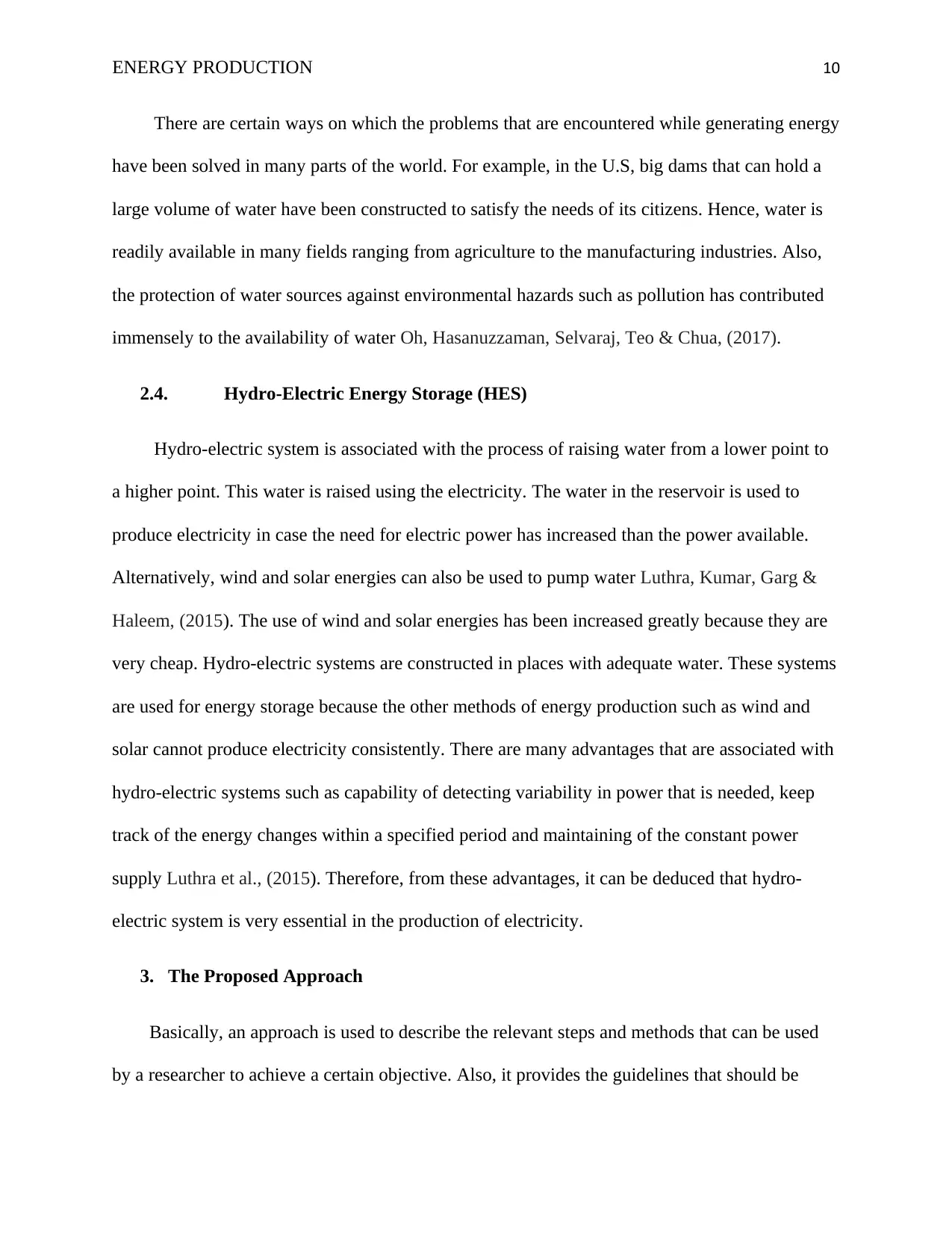
ENERGY PRODUCTION 10
There are certain ways on which the problems that are encountered while generating energy
have been solved in many parts of the world. For example, in the U.S, big dams that can hold a
large volume of water have been constructed to satisfy the needs of its citizens. Hence, water is
readily available in many fields ranging from agriculture to the manufacturing industries. Also,
the protection of water sources against environmental hazards such as pollution has contributed
immensely to the availability of water Oh, Hasanuzzaman, Selvaraj, Teo & Chua, (2017).
2.4. Hydro-Electric Energy Storage (HES)
Hydro-electric system is associated with the process of raising water from a lower point to
a higher point. This water is raised using the electricity. The water in the reservoir is used to
produce electricity in case the need for electric power has increased than the power available.
Alternatively, wind and solar energies can also be used to pump water Luthra, Kumar, Garg &
Haleem, (2015). The use of wind and solar energies has been increased greatly because they are
very cheap. Hydro-electric systems are constructed in places with adequate water. These systems
are used for energy storage because the other methods of energy production such as wind and
solar cannot produce electricity consistently. There are many advantages that are associated with
hydro-electric systems such as capability of detecting variability in power that is needed, keep
track of the energy changes within a specified period and maintaining of the constant power
supply Luthra et al., (2015). Therefore, from these advantages, it can be deduced that hydro-
electric system is very essential in the production of electricity.
3. The Proposed Approach
Basically, an approach is used to describe the relevant steps and methods that can be used
by a researcher to achieve a certain objective. Also, it provides the guidelines that should be
There are certain ways on which the problems that are encountered while generating energy
have been solved in many parts of the world. For example, in the U.S, big dams that can hold a
large volume of water have been constructed to satisfy the needs of its citizens. Hence, water is
readily available in many fields ranging from agriculture to the manufacturing industries. Also,
the protection of water sources against environmental hazards such as pollution has contributed
immensely to the availability of water Oh, Hasanuzzaman, Selvaraj, Teo & Chua, (2017).
2.4. Hydro-Electric Energy Storage (HES)
Hydro-electric system is associated with the process of raising water from a lower point to
a higher point. This water is raised using the electricity. The water in the reservoir is used to
produce electricity in case the need for electric power has increased than the power available.
Alternatively, wind and solar energies can also be used to pump water Luthra, Kumar, Garg &
Haleem, (2015). The use of wind and solar energies has been increased greatly because they are
very cheap. Hydro-electric systems are constructed in places with adequate water. These systems
are used for energy storage because the other methods of energy production such as wind and
solar cannot produce electricity consistently. There are many advantages that are associated with
hydro-electric systems such as capability of detecting variability in power that is needed, keep
track of the energy changes within a specified period and maintaining of the constant power
supply Luthra et al., (2015). Therefore, from these advantages, it can be deduced that hydro-
electric system is very essential in the production of electricity.
3. The Proposed Approach
Basically, an approach is used to describe the relevant steps and methods that can be used
by a researcher to achieve a certain objective. Also, it provides the guidelines that should be
Paraphrase This Document
Need a fresh take? Get an instant paraphrase of this document with our AI Paraphraser
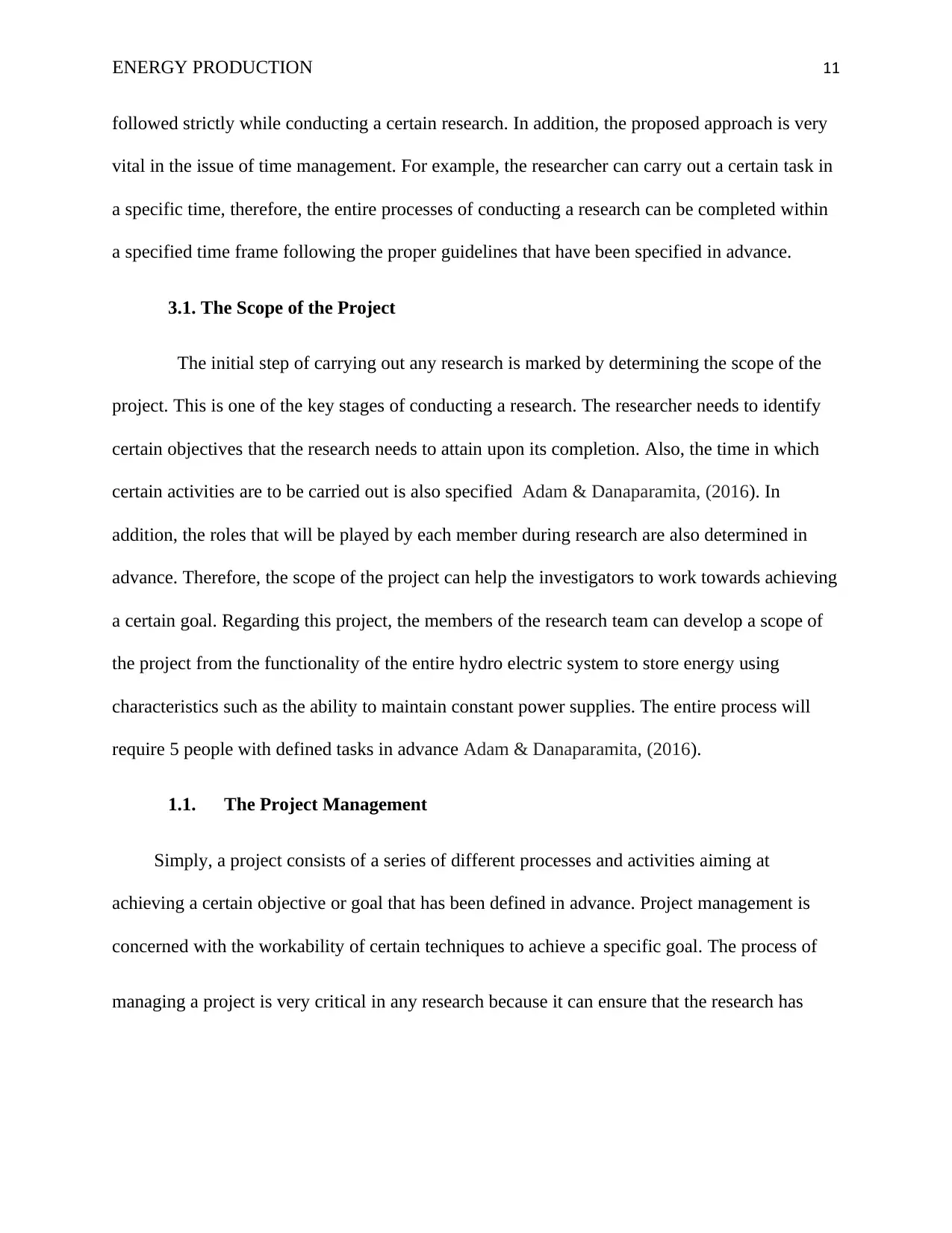
ENERGY PRODUCTION 11
followed strictly while conducting a certain research. In addition, the proposed approach is very
vital in the issue of time management. For example, the researcher can carry out a certain task in
a specific time, therefore, the entire processes of conducting a research can be completed within
a specified time frame following the proper guidelines that have been specified in advance.
3.1. The Scope of the Project
The initial step of carrying out any research is marked by determining the scope of the
project. This is one of the key stages of conducting a research. The researcher needs to identify
certain objectives that the research needs to attain upon its completion. Also, the time in which
certain activities are to be carried out is also specified Adam & Danaparamita, (2016). In
addition, the roles that will be played by each member during research are also determined in
advance. Therefore, the scope of the project can help the investigators to work towards achieving
a certain goal. Regarding this project, the members of the research team can develop a scope of
the project from the functionality of the entire hydro electric system to store energy using
characteristics such as the ability to maintain constant power supplies. The entire process will
require 5 people with defined tasks in advance Adam & Danaparamita, (2016).
1.1. The Project Management
Simply, a project consists of a series of different processes and activities aiming at
achieving a certain objective or goal that has been defined in advance. Project management is
concerned with the workability of certain techniques to achieve a specific goal. The process of
managing a project is very critical in any research because it can ensure that the research has
followed strictly while conducting a certain research. In addition, the proposed approach is very
vital in the issue of time management. For example, the researcher can carry out a certain task in
a specific time, therefore, the entire processes of conducting a research can be completed within
a specified time frame following the proper guidelines that have been specified in advance.
3.1. The Scope of the Project
The initial step of carrying out any research is marked by determining the scope of the
project. This is one of the key stages of conducting a research. The researcher needs to identify
certain objectives that the research needs to attain upon its completion. Also, the time in which
certain activities are to be carried out is also specified Adam & Danaparamita, (2016). In
addition, the roles that will be played by each member during research are also determined in
advance. Therefore, the scope of the project can help the investigators to work towards achieving
a certain goal. Regarding this project, the members of the research team can develop a scope of
the project from the functionality of the entire hydro electric system to store energy using
characteristics such as the ability to maintain constant power supplies. The entire process will
require 5 people with defined tasks in advance Adam & Danaparamita, (2016).
1.1. The Project Management
Simply, a project consists of a series of different processes and activities aiming at
achieving a certain objective or goal that has been defined in advance. Project management is
concerned with the workability of certain techniques to achieve a specific goal. The process of
managing a project is very critical in any research because it can ensure that the research has
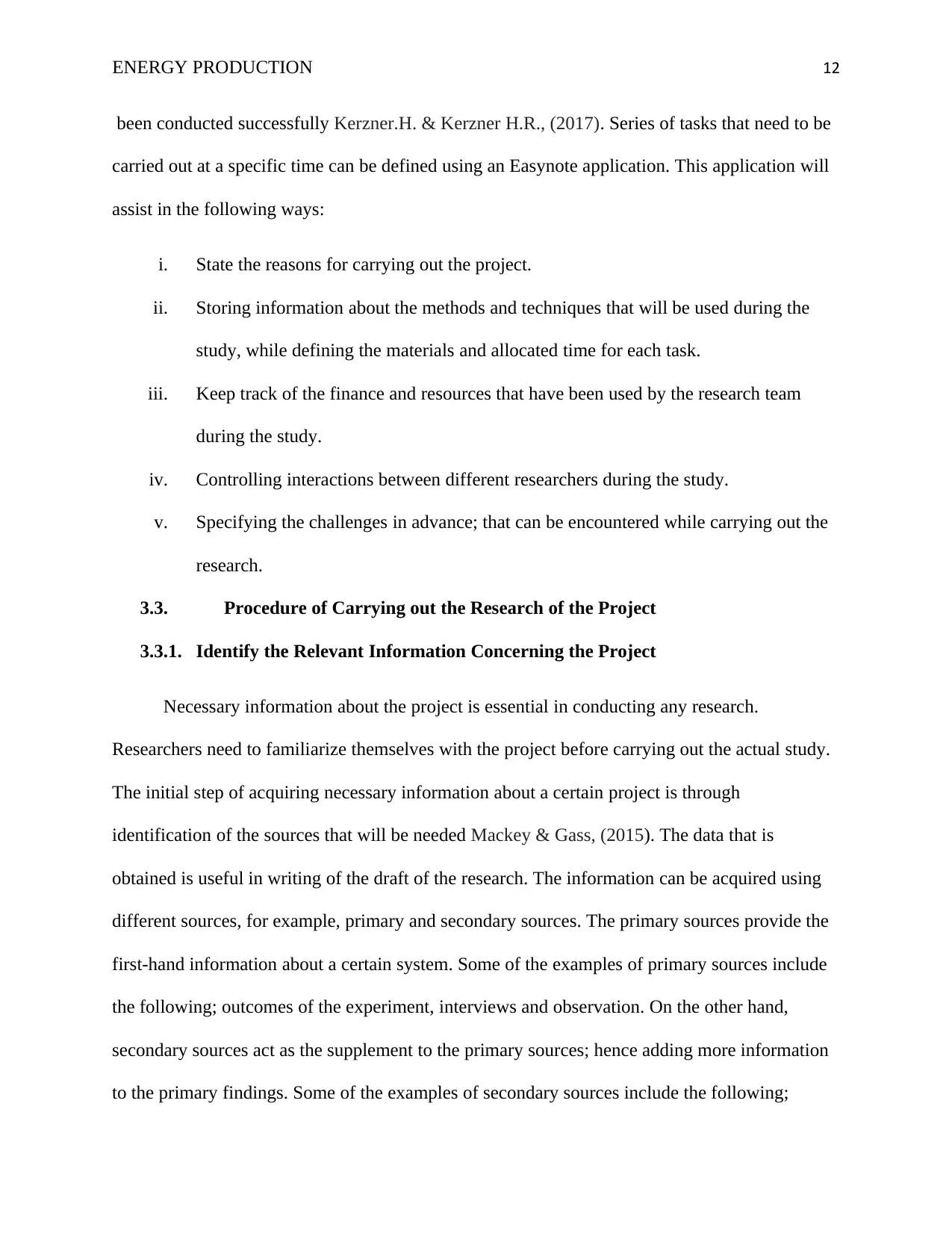
ENERGY PRODUCTION 12
been conducted successfully Kerzner.H. & Kerzner H.R., (2017). Series of tasks that need to be
carried out at a specific time can be defined using an Easynote application. This application will
assist in the following ways:
i. State the reasons for carrying out the project.
ii. Storing information about the methods and techniques that will be used during the
study, while defining the materials and allocated time for each task.
iii. Keep track of the finance and resources that have been used by the research team
during the study.
iv. Controlling interactions between different researchers during the study.
v. Specifying the challenges in advance; that can be encountered while carrying out the
research.
3.3. Procedure of Carrying out the Research of the Project
3.3.1. Identify the Relevant Information Concerning the Project
Necessary information about the project is essential in conducting any research.
Researchers need to familiarize themselves with the project before carrying out the actual study.
The initial step of acquiring necessary information about a certain project is through
identification of the sources that will be needed Mackey & Gass, (2015). The data that is
obtained is useful in writing of the draft of the research. The information can be acquired using
different sources, for example, primary and secondary sources. The primary sources provide the
first-hand information about a certain system. Some of the examples of primary sources include
the following; outcomes of the experiment, interviews and observation. On the other hand,
secondary sources act as the supplement to the primary sources; hence adding more information
to the primary findings. Some of the examples of secondary sources include the following;
been conducted successfully Kerzner.H. & Kerzner H.R., (2017). Series of tasks that need to be
carried out at a specific time can be defined using an Easynote application. This application will
assist in the following ways:
i. State the reasons for carrying out the project.
ii. Storing information about the methods and techniques that will be used during the
study, while defining the materials and allocated time for each task.
iii. Keep track of the finance and resources that have been used by the research team
during the study.
iv. Controlling interactions between different researchers during the study.
v. Specifying the challenges in advance; that can be encountered while carrying out the
research.
3.3. Procedure of Carrying out the Research of the Project
3.3.1. Identify the Relevant Information Concerning the Project
Necessary information about the project is essential in conducting any research.
Researchers need to familiarize themselves with the project before carrying out the actual study.
The initial step of acquiring necessary information about a certain project is through
identification of the sources that will be needed Mackey & Gass, (2015). The data that is
obtained is useful in writing of the draft of the research. The information can be acquired using
different sources, for example, primary and secondary sources. The primary sources provide the
first-hand information about a certain system. Some of the examples of primary sources include
the following; outcomes of the experiment, interviews and observation. On the other hand,
secondary sources act as the supplement to the primary sources; hence adding more information
to the primary findings. Some of the examples of secondary sources include the following;
⊘ This is a preview!⊘
Do you want full access?
Subscribe today to unlock all pages.

Trusted by 1+ million students worldwide
1 out of 22
Related Documents
Your All-in-One AI-Powered Toolkit for Academic Success.
+13062052269
info@desklib.com
Available 24*7 on WhatsApp / Email
![[object Object]](/_next/static/media/star-bottom.7253800d.svg)
Unlock your academic potential
Copyright © 2020–2025 A2Z Services. All Rights Reserved. Developed and managed by ZUCOL.





